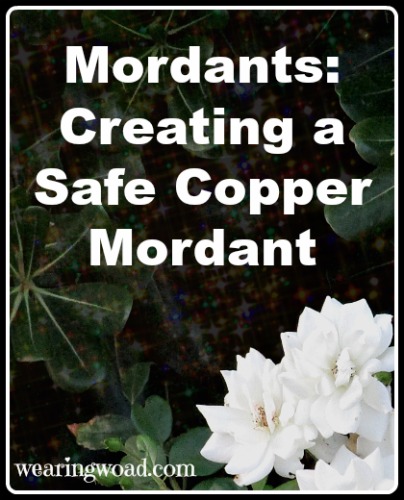Having talked a bit about mordanting in the past, I would like to focus in on a single mordant. Copper is one of the easiest mordants to create oneself, and while copper can be toxic in high quantities, a homemade mordant handled in the right way is still safe to use. There are two effective ways to create a copper mordant, one is using something that is copper in the dye process, and the other is dissolving some copper into another medium. While the first method is good for altering dye color, the second is better for acting as a standard mordant binding agent.
With copper, the absolutely safest method is that of, what I would term, an “incidental” mordant. Using this method, the mordant metal is a sub mordant to the main alum mordant and is used solely for the purpose of altering the color of the dyed material. 
Creating an Incidental Copper Mordant:
An incidental, or secondary, mordant’s primary purpose is to shift the color that the natural dye lays down. With copper, this can turn a yellow into a green, or alter a brown. Copper is usually not used with red dyes, a tin incidental mordant being preferred with reds.
To create an incidental copper mordant, you can drop a few pieces of copper pipe or tubing into your natural dye bath when you start brewing the dye. Leave the copper in the vat throughout the brewing and dyeing stages. Enough copper will leach from the tubing to alter the color of your dye, without it having a high enough concentration to be toxic.
Alternatively, a few dozen copper pennies (not brass or bronze, but copper if possible), can be dropped into the vat. Or, a copper lined pot could be used to prepare the dye vat.
Incidental mordants should be used with a pre-mordant of alum to firmly fix the dye. An incidental mordant can help fix the dye, but its primary purpose is to act as a color changing agent.
Note: If you have hard water, with either iron or copper already in the ground water, your water may already act as an incidental mordant. If you consistently get dull or muted natural dye colors, despite pH shifts and following other natural dye best practices, your water may be at fault. To test if your ground water has mineral contamination, do a small dye vat using distilled or rain water and use the same water for your mordanting process. If those colors are bright, then it is your water that is altering the dye color, not the dye material.
Creating a Main Copper Mordant:
Copper sulfite is a mineral powder, similar to powdered Alum, that is usually used to make a main copper mordant. However, if you would rather not fuss with the toxic powdered copper, you can make your own main copper mordant with a little creativity, and acidity.
Any acid will draw out metal molecules and suspend them, thus soaking copper pipe or tubing in vinegar will create an acidic copper suspension solution which can be used as a direct mordant.
Let your copper pipe, tubing, or pennies, soak in vinegar for a week and up to a month. You can either drop the copper pipe directly into a plastic container of white vinegar, or you can use a glass jar and fill with vinegar and the pieces of copper. You can leave the same copper in the same container, and just add more vinegar as you use it for your mordant.
Take a cup of the vinegar to 150 grams of wool. Add the vinegar to hot water, and then add your wool and simmer as for an alum mordant.
Note: Keep any vinegar and metal solution far away from children and pets. While the vinegar and copper suspension is a little safer than using copper sulfite, it can still be toxic if ingested. When you are finished using a copper mordant, make sure to safely dispose of it. Make sure to also safely dispose of any oxidized copper pipe or tubing left over from the vinegar solutions.
Back to You:
What is your favorite mordant? What mordants have you used in your natural dye endeavours?
If you would like to know more about mordants, you can check out an overview of the most common and safe mordants here.
If you liked this article, please leave a comment. I love hearing back from you!